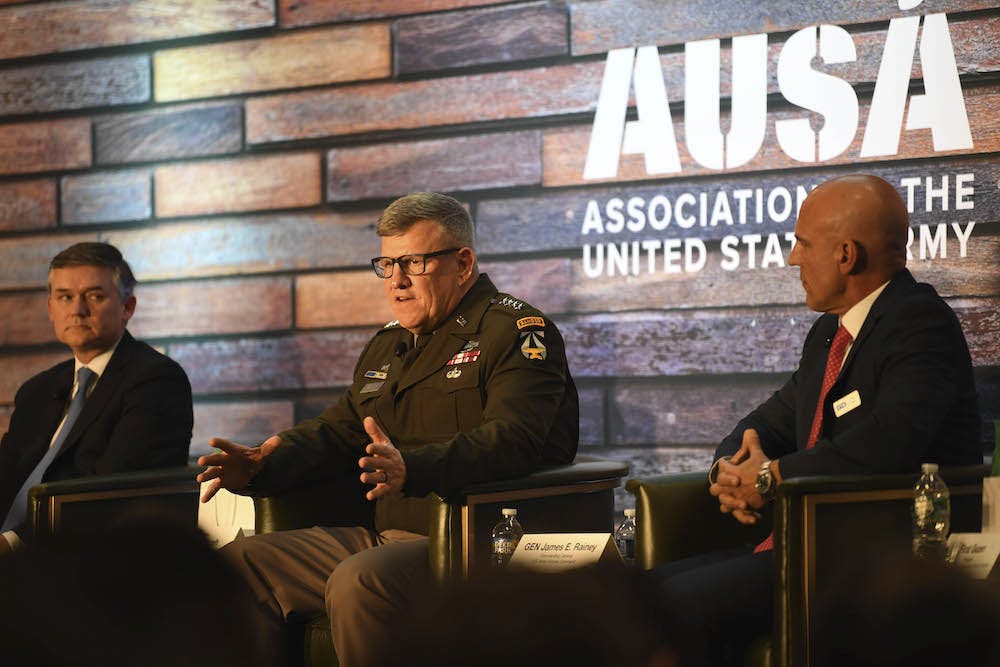Army Leaders: The Future Force Will Be Tech-Savvy
AI and other technologies will enable military personnel to be better warfighters.

Six years into the Army’s modernization plan, the service’s leaders are deliberating on how to fully integrate emerging technology like artificial intelligence into the battlefield.
Transformation and IT modernization were key themes at this year’s AUSA’s Annual Meeting and Exposition, where Gen. James Rainey, commanding general of the Army Futures Command, said “deliberate modernization” of the service is progressing, reducing timelines and sticking to initial priorities.
Rainey warned that there are “fundamental changes to warfare coming” on the horizon, and the time for the Army to adjust and adapt to them is now. According to Rainey, the Army’s command-and-control warfighting system needs to be ready to integrate emerging technologies that have the “potential to be incredibly disruptive” — like AI, machine learning, large language models and quantum computing — as soon as possible ahead of 2040.
Rainey said modernization has created opportunities for the Army to observe technology use cases in emerging hotspots like Ukraine and Israel, allowing the Army to turn those observations into “real capability in our formations.”
Rainey said that while the Army will still be able to adapt to technology as it arrives, it will require “commanders who are as good at leveraging technology as they are at reading terrain, doing combined arms maneuver and understanding the enemy.”
Army Acquisition, Logistics and Technology Assistant Secretary Douglas Bush said at the event that Congress’ support and flexibility has allowed the Army to acquire better technology on a faster scale, but added that congressional oversight is still very necessary to keep priorities in line.
Bush said mechanisms are being put in place to build government capacity to “understand AI and work with industry to evaluate it and field it quickly. There’s a government responsibility to understand what we’re buying and what we’re deploying, especially with a new technology that potentially is so transformational.”
Bush stated that the Army is taking steps to build its institutional knowledge of emerging technologies through efforts such as rotating officers with private industry to better understand how private industry tech can integrate with the Army.
However, Rainey believes that while the Army can build up its knowledge and understanding of AI and other emerging technologies, it shouldn’t try to compete with private industry.
“I think industry is always going to be better at and ahead of the Army and the military on AI,” Rainey said. “I think as we design the command-and-control warfighting system of the future that we need to get not one company, not vendor lock, but we need to get a handful of cutting edge companies integrated into that system as a service doing AI, doing ML, and making sure that we are always one step ahead of the enemy and we’re being predictive.”
This is a carousel with manually rotating slides. Use Next and Previous buttons to navigate or jump to a slide with the slide dots
-

GSA Urges OneGov Adoption to Accelerate Unified IT Modernization
GSA leaders say broader use of OneGov contracts will lower software costs, standardize terms and accelerate modernization across government.
3m read -

Securing AI Amid Rising Risks
NIST and Maximus explore how AI is transforming threat detection, identity protection and edge security and discuss how agencies can keep pace with the rapid tech changes.
20m watch -

Federal Modernization Hinges on Trusted Data, Simplified Procurement
Agency leaders are rethinking modernization strategies to meet the demands of data-driven missions and increasingly sophisticated cyber threats.
18m watch -

AI-Driven Modernization is Boosting Patient Satisfaction
UK public health leader says that AI and cloud tools can reshape patient interactions and back-office operations.
3m read








